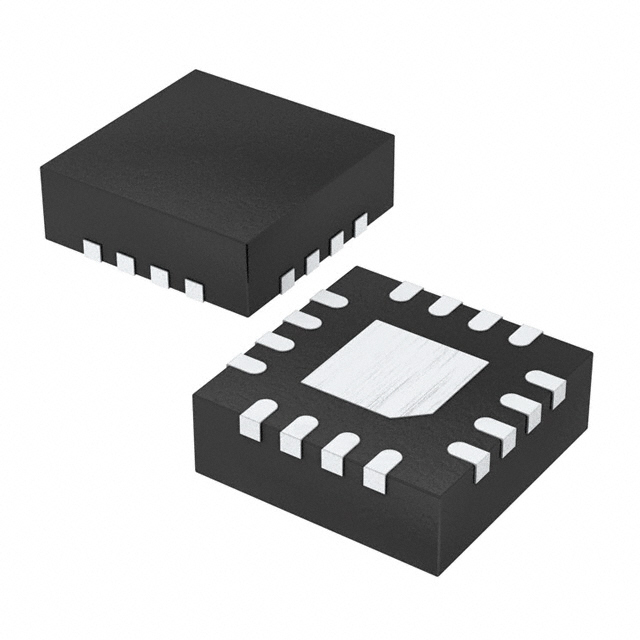MCP4251-503E/ML
Introduction
The MCP4251-503E/ML is a digital potentiometer belonging to the category of integrated circuits. It is commonly used in electronic devices to provide variable resistance and control voltage levels. This entry provides an overview of the MCP4251-503E/ML, including its basic information, specifications, pin configuration, functional features, advantages and disadvantages, working principles, application field plans, and alternative models.
Basic Information Overview
- Category: Integrated Circuits
- Use: The MCP4251-503E/ML is used as a digital potentiometer to adjust resistance and control voltage levels in electronic circuits.
- Characteristics: It offers digital control, non-volatile memory, and low power consumption.
- Package: The MCP4251-503E/ML is available in a small outline package (MLP) form factor.
- Essence: It serves as a replacement for traditional mechanical potentiometers, offering greater precision and flexibility.
- Packaging/Quantity: The MCP4251-503E/ML is typically supplied in tape and reel packaging with varying quantities based on manufacturer specifications.
Specifications
- Resolution: 8-bit
- Number of Channels: Dual-channel
- Interface Type: SPI (Serial Peripheral Interface)
- Operating Voltage: 2.7V to 5.5V
- Wiper Resistance: 75Ω (typical)
- Temperature Range: -40°C to +125°C
- Endurance: 1,000,000 write cycles per bit
Detailed Pin Configuration
The MCP4251-503E/ML features a standard dual in-line package (DIP) pin configuration with the following key pins: 1. VDD - Power supply input 2. VSS - Ground 3. CS - Chip select for SPI interface 4. SCK - Serial clock input 5. SI - Serial data input 6. SO - Serial data output 7. A/B - Analog inputs for channel selection 8. W - Wiper terminal for resistance adjustment
Functional Features
- Digital Control: Allows precise adjustment of resistance through digital signals.
- Non-Volatile Memory: Retains wiper position settings even when powered off.
- Low Power Consumption: Ideal for battery-powered applications.
Advantages and Disadvantages
Advantages
- Precise and repeatable resistance adjustments
- Compact form factor
- Reduced susceptibility to mechanical wear and tear
Disadvantages
- Limited maximum resistance value compared to some traditional potentiometers
- Sensitivity to electromagnetic interference in certain environments
Working Principles
The MCP4251-503E/ML operates by digitally controlling the position of the wiper terminal, effectively changing the resistance between the A/B pins. This digital potentiometer utilizes the SPI interface to receive control commands and store wiper position settings in non-volatile memory.
Detailed Application Field Plans
The MCP4251-503E/ML finds extensive use in various electronic applications, including: - Audio equipment: Volume and tone control circuits - Instrumentation: Calibration and signal conditioning - Industrial automation: Variable voltage regulation - Consumer electronics: Display brightness and contrast adjustment
Detailed and Complete Alternative Models
- MCP4261: Similar to MCP4251 but with 10-bit resolution
- AD8403: Digital potentiometer with parallel interface
- X9C103S: Non-volatile digital potentiometer with 100Ω end-to-end resistance
In conclusion, the MCP4251-503E/ML digital potentiometer offers precise and reliable resistance control in a compact and versatile package, making it an essential component in modern electronic designs.
Word count: 536
قم بإدراج 10 أسئلة وإجابات شائعة تتعلق بتطبيق MCP4251-503E/ML في الحلول التقنية
What is the MCP4251-503E/ML?
The MCP4251-503E/ML is a digital potentiometer that can be used to digitally control resistance in various technical solutions.What is the typical voltage range for MCP4251-503E/ML?
The typical voltage range for MCP4251-503E/ML is 2.7V to 5.5V.What is the resolution of MCP4251-503E/ML?
The MCP4251-503E/ML has a resolution of 8 bits.Can MCP4251-503E/ML be used in audio applications?
Yes, MCP4251-503E/ML can be used in audio applications for volume control and tone adjustment.Is MCP4251-503E/ML suitable for use in industrial automation?
Yes, MCP4251-503E/ML is suitable for use in industrial automation for controlling parameters such as motor speed and system calibration.What is the interface of MCP4251-503E/ML?
MCP4251-503E/ML uses a SPI (Serial Peripheral Interface) for communication with microcontrollers or other devices.Can MCP4251-503E/ML be used in battery-powered devices?
Yes, MCP4251-503E/ML's low power consumption makes it suitable for use in battery-powered devices.What are the temperature operating ranges for MCP4251-503E/ML?
MCP4251-503E/ML has an extended temperature range from -40°C to 125°C, making it suitable for harsh environments.Does MCP4251-503E/ML have non-volatile memory?
Yes, MCP4251-503E/ML has non-volatile memory, allowing it to retain its settings even when powered off.Can multiple MCP4251-503E/ML devices be daisy-chained together?
Yes, multiple MCP4251-503E/ML devices can be daisy-chained together to expand the number of digital potentiometers in a system.


